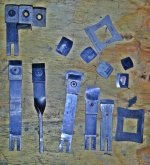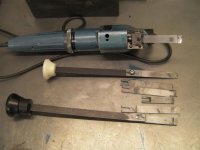You know I just realized that I am assuming that there is more than one mfg of power scrapers. Does anyone other than Biax make them
Renz- Airo is the only other brand that I know of.
RENZ-Eiro Apparatebau und Vertrieb: RENZ Elektronik-Schaber A20
That's what I carry. I love mine to death. Rich K had seen one years ago, and didn't like it. The Renz is actually lighter and has a touch more power. I think its a Fein motor, is doesn't seem to slow down despite the load.
Its had that rectangular shaft forever, its always tracked very well. But having said that I work with some one that has the newer Biax, with the slide built in. That's a beautiful machine as well.
As far as tooling, it either clamps in, or its one or two holes in the shank. You can make or modify anything.
Regards Phil.
(On Edit) P.S Can I tell stories here? It ties in with other manufacturer of power scrapers.
I was on site here in Melbourne. Large company,(@ R.C, the company you are thinking of) and I bumped into this tech from Brisbane / Queensland.
This bloke had a habit of running his mouth off, to the point where you couldn't get a word is side ways.
First rule broken, there's not that much machine tool action in Brisbane.
Second rule broken, he proceeds to tell me about Turcite. But he pronounce it Tur-Site. Down here we say Tur-Kite.
Then he avails me with stories of going to Singapore to scrap in Tur-site.
I ask him what gun he slings, expecting him to be a Biax or Renz man. But he tells me Bosch.
I figure that makes sense, Bosch being German, that would be the one company in the world that might come up with a new power, machine tool scraper.
I get back to the workshop, I spent an hour and a half on Google trying to find it. With no luck.
So I get back on site next morning, and I ask him to show me this machine tool scraper. He has one of these. With a Stanley knife blade attached. W.T.F






